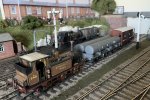oldravendale
Western Thunderer
I really like a K. Ace Kit? In which case I know what has been gone through to reach this result. 
Brian

Brian

Considerable scratch building and therapy for bad language. Yes, it’s and Ace kit. My one and only. Seriously Brian, I found the account of your build in WT most helpful. Thank you.I really like a K. Ace Kit? In which case I know what has been gone through to reach this result.
Brian

Thank you John. I was determined to have a K Class. Determination paid off in the end. I also enjoyed the scratchbuilding as well and I quite understand when modellers say it is easier/preferable to scratchbuild. Some of the parts in this kit were awful and just had to be re-made.Oh that really is very nice.
John







I’ve used terminal blocks as support for the point rods which run in brass tubing secured in the terminal blocks by the two screws.
